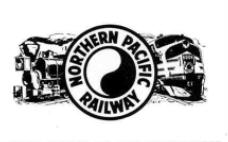Last Spike Ceremonies
The ceremony of the driving of the last spike was held on September 8, 1883, at Gold Creek. A great pavilion was erected at this location, capable of seating more than a thousand people, over which floated the national colors of the American, British, and German nations.
Music was furnished by the 5th Infantry Band, which came all the way from Ft. Keogh for the occasion. Representatives of Germany, England, and the Scandinavian countries were there in special trains, and some three thousand people witnessed the ceremony. Many eminent Americans were on hand, including ex-President Ulysses S. Grant. In only a few instances in history has such a distinguished assemblage participated in an event of this kind.
There were cabinet officials; ten United States senators and three former senators; twenty-six congressmen and four former congressmen; nine governors of states and four ex-governors; nine army generals; twenty-five leading railroad executives; judges; mayors, and fifty journalists. Eminent among the latter were three of the nation's greatest editors: Joseph Pulitzer of New York, Joseph Medill of Chicago, and Carl Schurz of New York. In the party also were the British Minister, L. Sackville West and Sir James Hannen of Great Britain and the German Minister, Baron von Eisendockor.
As soon as the last of the guests had taken their places in the pavilion, the ceremonies were opened by President Villard; and he now shall have the privilege of describing in his own words the work which had been done. He said in part:
"Work on the main line was first resumed (after the suspension growing out of the panic in 1873) on the west bank of the Missouri River in the spring of 1870, and at the confluence of the Columbia and Snake Rivers in the fall of the same year. The distance between the two starting points was 1,122 miles. The 217 miles from the Missouri to the Yellowstone were completed in June 1881; the 225 miles from the Columbia to Lake Pend Oreille in November 1881; the completion of the 340 miles of road in the Yellowstone Valley took 17 months; the 194 miles up the gorges of Clark's Fork to Missoula 19 months; from the head of the Yellowstone Valley to Helena and thence to Gold Creek, 9 months.
"Thus the first 442 miles of the total mileage to be completed that is, the Missouri and Pend Oreille Divisions were finished in two years and eight months while the other 780 miles were completed in less than two years. In this time, the great structure of the Bismarck bridge over the Missouri River was also constructed. The continuation of the main line down the Columbia for a length of 210 more miles by another company to Portland and 1,000 additional miles of branch and allied company lines were finished.
"Now figures are easily quoted and apparently speak a very simple language, but their true meaning goes far beyond the mere space of time and mileage of completed road they indicate. They form a great sum of human patience and perseverance, energy and bravery, hardship and privation. They express long and hard tests of the power of human ingenuity and endurance in a mighty struggle of mechanical and manual forces against the direct obstacles of primitive nature. They mean a painful record of bodily suffering and loss of life by disease and accident."
After this brief address by Mr. Villard, he then introduced The Honorable William M. Evarts, former U. S. Secretary of State, who delivered an inspiring oration. Ex-President Billings of the Northern Pacific and U. S. Secretary of the Interior H. M. Teller also spoke. Then General Grant was introduced, and as he came forward to speak there was a mighty cheer. In the course of his remarks he reminded his audience that many years before, as an acting Lieutenant Quartermaster on the Columbia River, he had issued supplies to Isaac I. Stcvens, who conducted the original surveys for the northern route under the authorization of Congress.
After the speaking and the taking of photographs, a horse that had hauled rail for building the road from its inception was brought to the platform. Then some three hundred men quickly laid the rail and drove the spikes on the last one thousand feet of track, all except the last spike which was driven by H. C. Davis, a passenger agent of the Northern Pacific, by General Grant, and Mr. Villard. It was the identical first spike which had been used near Carlton, Minnesota, thirteen years before, when the first rails were laid at that point.
The ceremony ended, and as the sun set behind the western mountains, special trains, which had brought together this distinguished company, simultaneously started, with prolonged whistling, for both the east and the west.

